Genre: Action/RPG Developer: Taito Publisher: Taito Players: 1-2 Released: 1992
I think that one of the most charming things about 16-bit gaming was how easy it was to just experiment with things and see how they turned out. As the industry went on, there were fewer things to try for the less creative developers and the industry as a whole suffered from this. It was so much easier to be jaded. No more could one just fuse two genres, say the platformer and the RPG. Then, that might be why I still savor my 16-bit goodness, and I always loved platformer RPG’s. Enter Cadash.
Cadash was an awesome little Taito game that was originally released in the arcades. That’s pretty common for titles from ’91, of course. It was a fun little romp in which an evil Balrog demon decided to prove that it was the most badass of all the evil demons, attacked your kingdom, and stole your princess. Is it much of story? Well, at least the Balrog’s doing this for a slightly better reason than ‘just because I can.’ But, other than that, no, it’s not much of a story. Still, for games of this type, Cadash isn’t at all shafted. All NPC’s have something to say to you that isn’t entirely pointless, although more than a few comments are a little random.
Cadash takes the basic idea of a platformer and throws in a few RPG elements for good measure. The first thing you notice is that there are two characters to play from and a two-player option. This is a bit of a slap in the face; in the arcade version there were four characters rather than three and losing two of them (the priestess and ninja) just isn’t a good feeling. Especially given the fact that, while the fighter and mage are quite cool, they’re also rather generic. It’s also kind of irritating considering that the good old Turbo Grafx-16 got its port of the game a year later with all the characters instead of half. This could all be forgiven of course, if Cadash played extremely well. Is this the case? Well, yes and no.
I certainly won’t fault the game on an aesthetic level. While the graphics have obviously taken a hit, coming from the arcade, they’re very mobile and very nice looking in a dark muted sort of way. The limited color options on the Genny actually lend the game quite a bit of fitting atmosphere and everything looks very nice. The level of detail isn’t that great, but everything fits together, and has nicely drawn figure. We even got a little spurt of blood for every enemy that dies.
On the other hand, the music is fairly average. When playing the game, it will all seem to be in place and keep you going happily enough, but the moment you stop, or press the pause button, you’ll have a hard time recalling just what was playing. There are a couple of exceptions to the rule, but almost all of the tracks are pretty bland. There might be two that aren’t.
The core of the gameplay is spent wandering through these ‘hub’ caves. Each cave is connects to another kingdom with more NPC’s, a respite from fighting, and most importantly, shops where you can buy better equipment and healing items. In the caves, however, you find your enemies and bosses and can progress through the game. Cadash runs amazingly smoothly, but the controls are a little awkward to get a handle on. A and C jump while B attacks, with a sword or a staff depending on your mode of play. The problem is that, while the attack is smooth, there is a barely noticeable pause after the attack executes but before you can attack again. It’s easy to work around and to master, but it does lead to some annoyances when swarmed with enemies. The jump control is also responsive and smooth, but the jumping mechanic itself is kind of awkward, and it doesn’t carry you very far or very high. This leads to way too many cheap hits or falls into water. The controls, however, are very responsive, and with some practice, can be mastered and made the most of.
The learning curve in the controls would be forgivable, but, until you get over the curve, the game can be a bit overbearing in its difficulty. Cadash isn’t incredibly hard, but it will make you work to keep going. This being an arcade game originally, the enemies are endless and if you’re not fast enough you’ll be hopelessly surrounded very quickly. A good number of the enemies are also small enough to be difficult to hit, or fast enough to get off a cheap one. That’s ignoring the bosses, who can be beaten with skill, and sometimes, a good amount of luck. To add to the challenge is the relative sparseness of healing items and the limited use you have of them. Medical herbs alone restore thirty HP, but before you’ll even want to think about tackling the Black Pudding (first boss) you’ll want to gain a few levels, and you see how relatively little that is.
Gaining levels in the caves is the main RPG element of the typical gameplay. After you kill enough enemies and meet a quota for experience points, you level up getting more HP so you can last longer. You also get luscious amounts of gold which you’ll be grateful for, once you reach the town. Even so, merely leveling up won’t yield you any easy victories over pesky bosses. These guys pack a wallop and you need magic or better equipment if you keep losing (assuming that you have gotten over those controls)
Admittedly, playing with a friend changes all of this and the difficulty is toned down considerably. It makes taking on all creatures a deal easier, although you’ll still need a little bit of practice controlling the game. Perhaps the greatest travesty of Cadash is that it offers no save feature or password. The game’s a marvel to play, but it’s just long enough that having to beat it in one sitting is a bit long and losing all of your luscious levels and effort is sheer torture. Might have to leave the black box running for this one.
In the end, though it might sound like I’m knocking the game, I’m not. I admit it, I love Cadash. It’s got a slightly better than usual plot, a great quest, fun multi-player, decent music. Unfortunately, it also has issues with control, difficulty, and the lack of some kind of save feature. The title is solidly above average, but it definitely falls short in some regards. Ah, it’s at times like this I wish I could decimal my score for clearer accuracy.
Screen shots property of Game Legacy.
SCORE: 6 out of 10

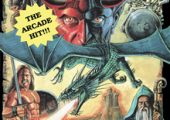
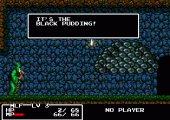
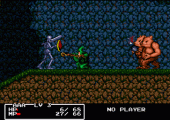
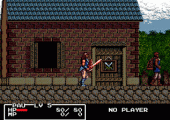
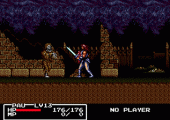
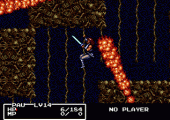
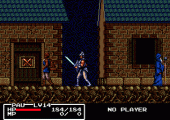
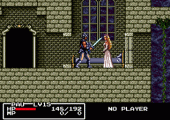
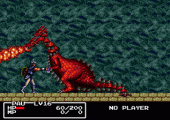
I had a blast playing/beating this arcade port of Cadash. Supposedly it’s inferior to the TG-16 port, but I find it is only inferior in terms of limited characters. In my opinion, the gameplay is much better here. I have played and beat the game on a friend’s arcade emulator, and I say the Genesis version does it justice. Leveling up early is key, but that only takes a few minutes. I miss these arcade games on home consoles today.
Many criticize Taito releases on the Genesis, but I don’t have a problem with them. I own Growl, Sagaia, Cadash, and probably more, and while they’re not the prettiest/best sounding, they all play well and look fine next to most Genesis titles. I continue to go back to them.